A Guide to Chat Customer Service Metrics and Their Meanings
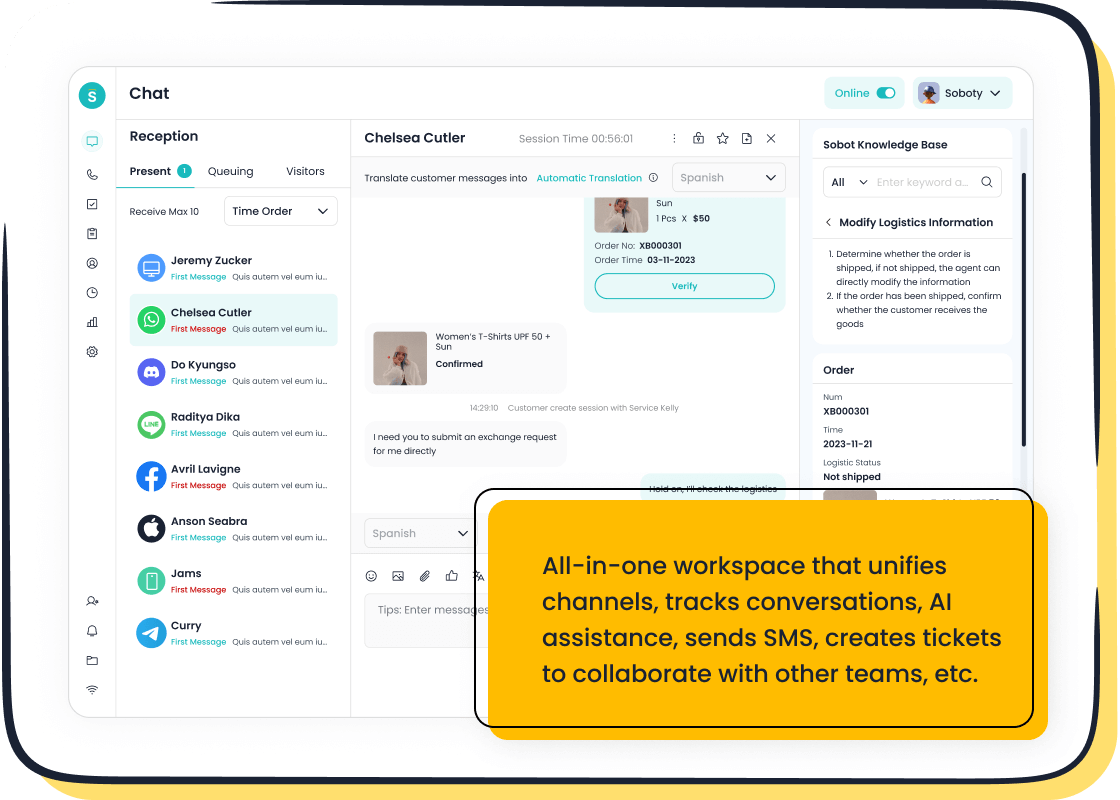
You need to track customer service metrics to keep your customer service level high. Metrics like first response time, customer satisfaction score, and key performance indicators help you measure your customer service level and improve your customer experience. Sobot Live Chat uses customer service metrics to raise your service level and boost operational level. First response time matters because 90% of customers want immediate replies. Sobot AI and Sobot call center monitor customer service levels to keep your level above industry standards. Companies using chat customer service metrics see 80% more revenue and better customer service level.
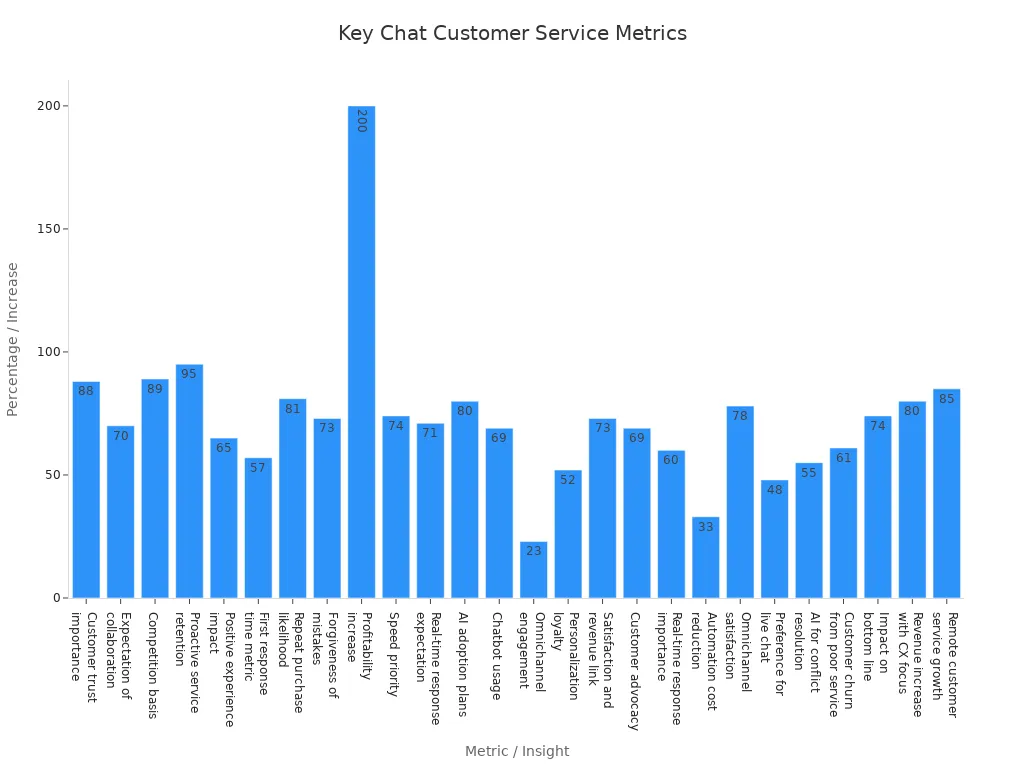
Chat Customer Service Metrics Overview
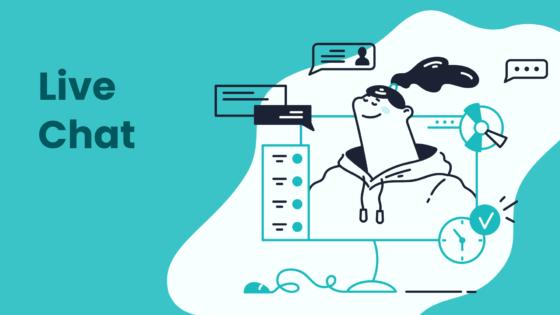
What Are Customer Service Metrics?
Customer service metrics help you measure how well your team supports customers. These metrics show the quality, speed, and effectiveness of your service. In chat environments, you track things like how fast you reply, how many issues you solve, and how happy your customers feel after each chat. You use these numbers to see where you do well and where you need to improve. Good customer care metrics are easy to measure, accurate, and give you clear actions to take.
Some of the most common chat customer service metrics include:
- First Response Time
- Average Reply Time
- Average Resolution Time
- Customer Satisfaction Score (CSAT)
- Net Promoter Score (NPS)
- Conversation Abandonment Rate
- Unresolved Ticket Rate
- Self-Service Resolution Rate
- Agent Performance Metrics
These metrics help you understand both the quality and quantity of your customer support.
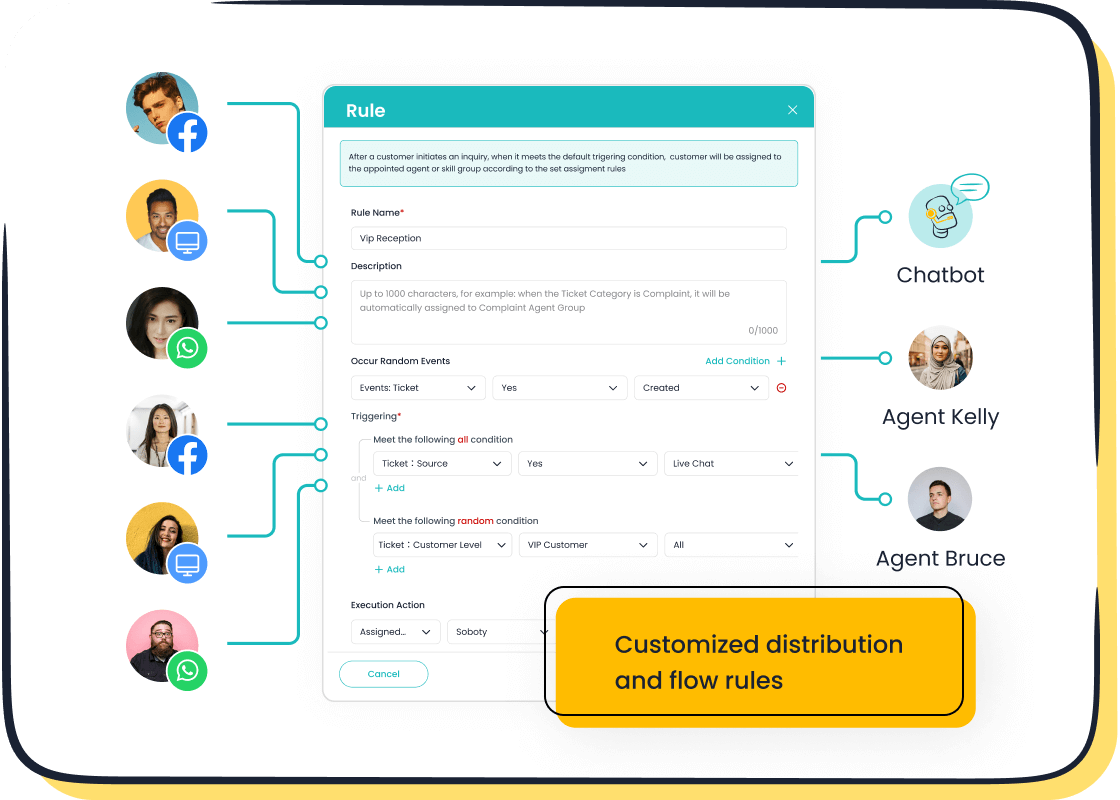
Why Metrics Matter for Sobot Live Chat
You need to track customer service metrics to keep your service strong. Sobot Live Chat uses these metrics to help you improve every part of your customer support. For example, OPPO used Sobot to reach an 83% chatbot resolution rate and a 57% increase in repeat purchases. Samsung improved its customer satisfaction rate to 97% with Sobot’s real-time insights. Sobot gives you over 300 reports and thousands of indicators, so you always know how your team performs. When you use Sobot, you can reduce agent workload by 60% and boost your Net Promoter Score by 35%. These results show why tracking chat customer service metrics is so important.
Key Performance Indicators in Chat Support
Key performance indicators, or KPIs, are the main numbers you use to measure your chat support. These include:
- First Response Time (how quickly you answer)
- First Contact Resolution (how often you solve issues in one chat)
- Average Resolution Time (how long it takes to fix problems)
- Customer Satisfaction Score (how happy customers are after chatting)
- Net Promoter Score (how likely customers are to recommend you)
You use these KPIs to spot trends, coach your team, and make sure your customer care metrics stay high. Sobot Live Chat helps you track all these KPIs in one place, making it easier to deliver great customer support every day.
First Response Time
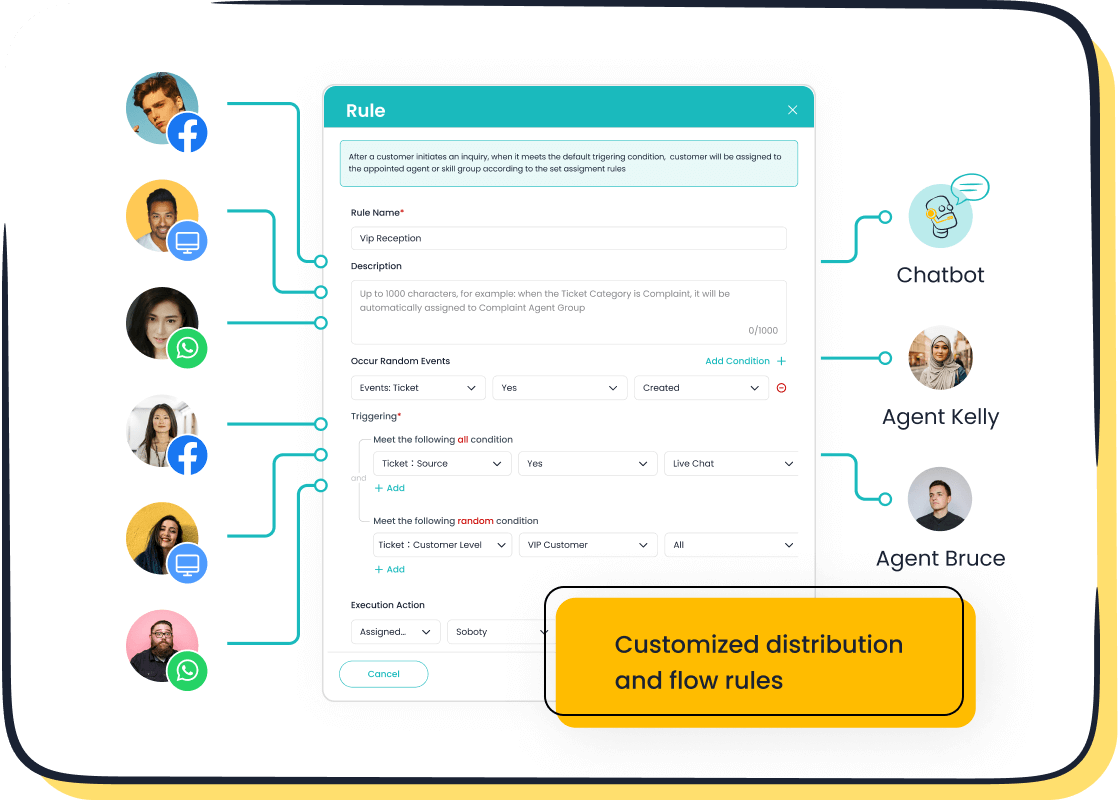
Definition and Calculation
First response time measures how quickly your support team replies to a customer’s first message. This metric starts when a customer sends a chat and ends when an agent gives the first real answer. Automated replies do not count. You calculate first response time by adding up all the response times in a set period and dividing by the number of tickets. For example, if your team spends 85,000 seconds on 900 tickets, your average first response time is about 94 seconds. Most chat customer service metrics platforms, like Sobot Live Chat, track this automatically. Industry standards say you should aim for a first response time of 60 seconds or less. Many customers expect even faster replies, with the best teams answering instantly.
Impact on Customer Experience
First response time has a big effect on customer experience. When you reply quickly, customers feel valued and trust your service. Research shows that faster replies lead to higher satisfaction and more repeat business. A Harvard Business Review study found that quick responses increase the chance of conversion and loyalty. If your first response time is slow, customers may leave negative feedback or stop using your service. Setting clear goals, like answering within one minute, helps your team stay focused and improves customer experience.
Tip: Training your team and using smart tools can lower your first response time and boost satisfaction.
Improving First Response Time with Sobot
Sobot Live Chat gives you many ways to improve first response time. The platform uses AI-powered chatbots to handle simple questions right away. Advanced natural language processing helps route chats to the right agent fast. Sobot’s unified workspace lets agents see all messages in one place, so they never miss a chat. Real-time monitoring and alerts help you spot delays and fix them quickly. With Sobot, you can meet or beat the industry standard for first response time, even during busy periods. These features help you deliver a better customer experience and keep your support team efficient.
Average Resolution Time
Measuring Resolution Time
You need to know how long it takes to solve customer problems from start to finish. The average resolution time tells you this. You measure it by adding up the total time your team spends resolving all customer chats, then dividing by the number of resolved tickets. For example, if your team resolves 10 chats in 17 minutes, your average resolution time is 1.7 minutes per chat. Most chat platforms, including Sobot Live Chat, track this for you. The clock starts when a customer sends a message and stops when the issue is fully solved. This metric helps you see how efficient your support team is.
Here is a table showing average resolution time across different industries:
| Industry | Average Resolution Time (minutes) |
|---|---|
| All industries | Under 8:30 |
| Retail and eCommerce | Under 6 |
| Shipping and Logistics | Under 4 |
| Telecommunications | Under 9 |
| Financial Services & Banking | Under 5 |
| Services | Under 9 |
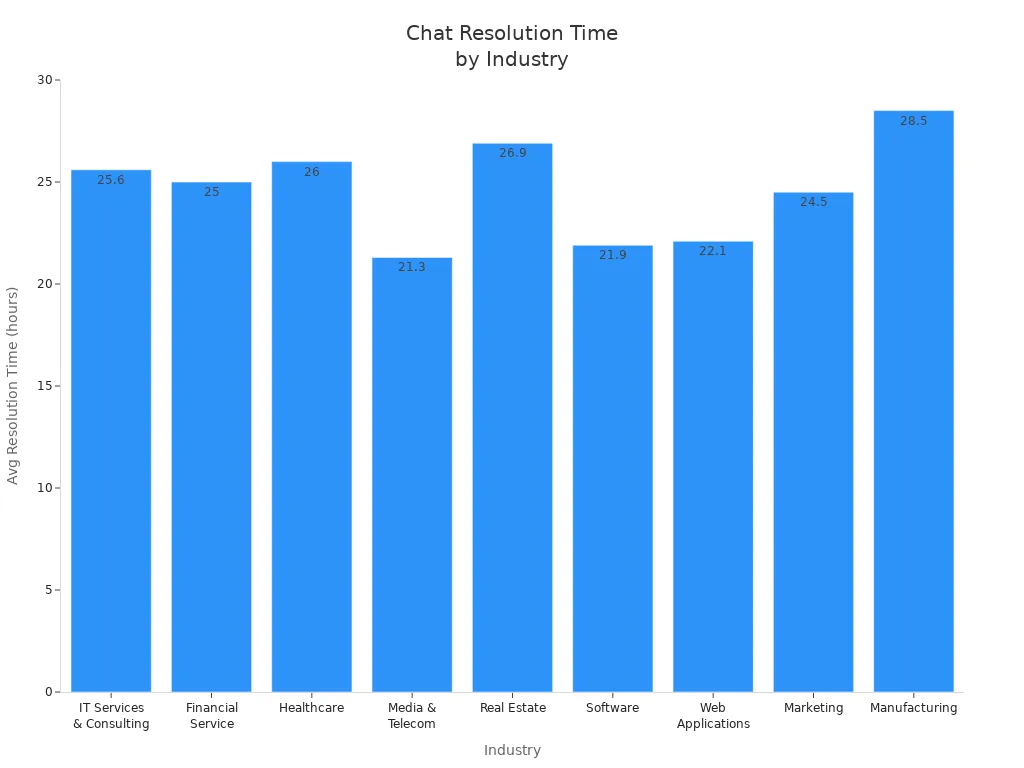
Effects on Customer Satisfaction
Average resolution time shapes how customers feel about your service. Studies show that 83% of customers feel more loyal to brands that solve their issues quickly. When you keep your average resolution time low, you show respect for your customers’ time. Fast problem-solving builds trust and encourages customers to return. If your average resolution time is high, customers may feel frustrated and less likely to recommend your brand. A quick resolution also means fewer support tickets and less stress for your team.
Tip: Focus on first contact resolution. Solving issues in one chat boosts satisfaction and lowers your average resolution time.
Sobot Live Chat Solutions
Sobot Live Chat helps you lower your average resolution time with smart tools. The platform uses AI-powered automation to handle simple questions fast. This lets your agents focus on complex issues. Sobot’s workflow automation can cut your average resolution time by up to 50%. For example, if your team took 60 minutes before, automation can bring it down to 30 minutes. Real-time analytics let you track your average resolution time and spot trends. You can use these insights to train your team and improve your service. Sobot’s unified workspace keeps all chats and data in one place, making it easy for agents to find answers quickly. With Sobot Live Chat, you can meet industry standards and keep your customers happy.
Ticket Volume and Resolution Rate
Tracking Support Efficiency
You need to track ticket volume to understand how busy your support team is. Ticket volume measures the number of customer requests your team receives over a set period. On average, companies handle about 578 tickets per day, 3,991 per week, and 17,630 per month. Each agent manages around 17 interactions daily, but this number changes depending on your industry and team size. For example, telecommunications agents spend about 525 seconds per chat, while retail agents spend around 324 seconds. Monitoring ticket volume helps you balance workloads and prevent agent burnout. You can also use ticket resolution rate to see how many tickets your team solves. Calculate this by dividing the number of closed tickets by the total tickets, then multiply by 100. A high resolution rate means your team is efficient and meets service goals.
Note: Tracking first contact resolution helps you see how many issues your team solves on the first try. This boosts customer satisfaction and lowers repeat tickets.
Sobot's Unified Workspace
Sobot Live Chat gives you a unified workspace that brings all tickets, chats, and customer data together. You see every ticket volume trend in real time. The platform uses built-in analytics to show how many tickets each agent handles and how quickly they resolve issues. You can customize reports to spot patterns and improve team performance. Sobot’s AI-powered tools help route tickets to the right agent, making sure no ticket gets missed. The unified workspace also supports omnichannel communication, so you manage ticket volume from websites, apps, and social media in one place. This makes your support team more efficient and helps you meet your resolution goals.
Managing High Volume
When ticket volume rises, you need smart strategies to keep service quality high. You can set up self-service options like FAQs and knowledge bases to let customers solve simple problems themselves. Use automation and AI chatbots to answer common questions instantly. Categorize and prioritize tickets so urgent issues get solved first. Sobot’s analytics help you monitor ticket volume and spot trends, so you can train agents and improve workflows. Proactive support, like sharing solutions before problems happen, reduces ticket volume spikes. You do not always need more agents; focus on root causes and use technology to manage high ticket volume efficiently.
Customer Satisfaction Score
What Is CSAT?
You use customer satisfaction score (CSAT) to measure how happy your customers feel after a chat. CSAT is one of the most important chat customer service metrics. You ask customers to rate their experience right after a chat ends. Most companies use a simple question like, “How satisfied were you with your support today?” Customers pick a score, usually from 1 to 5. You calculate your customer satisfaction score by dividing the number of positive ratings by the total number of responses, then multiply by 100. For example, if 80 out of 100 customers give a positive rating, your customer satisfaction score is 80%. High CSAT scores show that your team delivers great service. Studies show that live chat channels often reach an average satisfaction rating of 88%. When you track your customer satisfaction score, you see how well your team meets customer needs.
Collecting and Using CSAT Data
You collect customer satisfaction score data using surveys sent right after each chat. Most chat platforms, including Sobot Live Chat, trigger these surveys automatically. You can send surveys through email, SMS, web, or in-app messages. These surveys let customers share their customer feedback instantly. You can customize questions and add follow-ups based on the customer satisfaction score. Sobot Live Chat gathers all survey results in one dashboard. You use these dashboards to spot trends, monitor agent performance, and find areas to improve. Real-time feedback helps you fix problems quickly and keep your customer satisfaction score high.
Tip: Always review your customer satisfaction score data to find patterns and train your team for better results.
Boosting CSAT with Sobot Live Chat
Sobot Live Chat gives you powerful tools to raise your customer satisfaction score. You can use customizable post-chat surveys to collect direct customer feedback. AI-powered chatbots answer questions instantly, making customers feel valued. Multilingual support with auto-translation helps you serve customers from different backgrounds, boosting customer satisfaction. Sobot tracks over 150 metrics, so you can find and fix common issues before they grow. Automated follow-ups show customers you care, which builds trust and loyalty. Studies show that 79% of customers prefer live chat for its speed and convenience. Sobot’s analytics dashboard lets you see your customer satisfaction score in real time and make changes fast. When you use Sobot Live Chat, you improve customer satisfaction, increase retention, and grow your business.
Metrics and Service Quality
Holistic Insights
You need a complete view of your customer service level to deliver the best quality. Tracking only one metric gives you a narrow picture. When you combine multiple customer service metrics, you see both the speed and the quality of your support. For example, you can measure first response time, average resolution time, and customer satisfaction together. This approach helps you spot problems early and understand what drives customer loyalty.
Here is a table showing how different types of metrics work together:
| Metric Category | Description | Examples and Insights |
|---|---|---|
| Quantitative Metrics | Show how fast and efficient your team works | First Response Time, Average Resolution Time, Ticket Volume. These help you find bottlenecks and improve productivity. |
| Qualitative Metrics | Reveal how customers feel about your service | Customer Satisfaction Score, Net Promoter Score. These explain why customers trust your brand and stay loyal. |
| Operational Metrics | Track agent performance and team consistency | Agent KPIs, Team Effectiveness. These help you coach your team and keep service quality high. |
You need to collect data from all channels and avoid data silos. Sobot’s unified workspace brings chat, calls, and social media into one dashboard. This integration gives you a full view of your customer service level and helps you make better decisions.
Enhancing Customer Loyalty
When you track customer service metrics, you improve both your service quality and customer loyalty. Research shows that 79% of customers prefer live chat for its speed. If you answer chats in under 60 seconds, you can boost conversions by 50%. Companies that keep chat abandonment rates below 5% see higher loyalty and Net Promoter Scores. Fast resolution times also lead to higher customer satisfaction. For example, a brand that solved chats in under five minutes raised its customer satisfaction score by 15 points. When you focus on first contact resolution, you reduce repeat tickets and build trust. These results show that high customer service levels lead to more loyal customers and better business outcomes.
Tip: Use customer feedback from post-chat surveys to find out what makes customers happy and loyal.
Continuous Improvement with Sobot
You need to keep improving your customer service level to stay ahead. Sobot supports you with an all-in-one omnichannel solution. The platform uses AI-powered chatbots to handle simple questions 24/7. Agents get training and real-time analytics to improve their skills. Sobot’s system tracks over 150 metrics, so you always know your service quality level. You can automate routine tasks, monitor key performance indicators, and use smart routing to connect customers with the right agent. Sobot helps you balance automation with human support, making sure your customer service levels stay high. Regular training and upskilling keep your team ready for new challenges. With Sobot, you create a closed-loop process that doubles efficiency and keeps your customer satisfaction and loyalty growing.
Tracking chat customer service metrics helps you raise your customer service level and keep your level of support high. You see your customer service level improve when you measure key metrics like CSAT, NPS, and FCR. Sobot Live Chat lets you monitor your customer service level in real time, so you can spot issues and keep your level of service strong. To boost your customer service level, use Sobot’s dashboard to track your level of performance, train your team to reach a higher customer service level, and analyze feedback to improve your level of service. Ongoing training and analytics help you maintain a top customer service level. When you focus on your customer service level and use key performance indicators, you drive business growth and build loyalty at every level.
FAQ
What are chat customer service metrics?
Chat customer service metrics help you measure how well your team supports customers through chat. You track things like response time, resolution rate, and customer satisfaction. These numbers show where you do well and where you can improve.
How does Sobot Live Chat help you track key performance indicators?
Sobot Live Chat gives you built-in analytics. You see over 150 indicators, including first response time and customer satisfaction score. The dashboard shows real-time data, so you can spot trends and make quick improvements.
Why should you care about first response time?
First response time shows how fast you answer customers. Quick replies make customers feel valued. If you respond slowly, customers may leave or give negative feedback. Sobot Live Chat helps you reply faster with AI-powered tools.
How can you improve your customer satisfaction score?
You can improve your customer satisfaction score by solving problems quickly and being friendly. Sobot Live Chat lets you send surveys after each chat. You use the feedback to train your team and fix common issues.
What makes Sobot different from other chat platforms?
Sobot offers omnichannel support, AI-powered chatbots, and a unified workspace. You manage all chats, tickets, and customer data in one place. This helps you boost efficiency and keep your chat customer service metrics high.
See Also
How To Successfully Oversee Your Live Chat Team
Comparing Expenses For Different Live Chat Support Options
Becoming An Expert In Live Chat Customer Assistance
